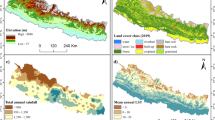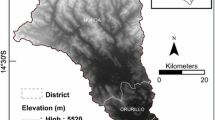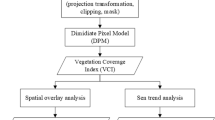Abstract
During the past half century, NDVI has been widely used for vegetation mapping and monitoring as well as in the assessment of land-cover and associated changes. This is because remotely sensed satellite-derived datasets provide spatially continuous data (data that are not sampled at individual points) and yield time-series signatures from which temporal patterns, trends, variations, and relationships may be derived (Jacquin et al. 2010). This has not prevented the misuse of NDVI—care is needed in the use of any scientific methodology.
Access provided by Autonomous University of Puebla. Download chapter PDF
Similar content being viewed by others
Keywords
These keywords were added by machine and not by the authors. This process is experimental and the keywords may be updated as the learning algorithm improves.
During the past half century, NDVI has been widely used for vegetation mapping and monitoring as well as in the assessment of land-cover and associated changes. This is because remotely sensed satellite-derived datasets provide spatially continuous data (data that are not sampled at individual points) and yield time-series signatures from which temporal patterns, trends, variations, and relationships may be derived (Jacquin et al. 2010). This has not prevented the misuse of NDVI—care is needed in the use of any scientific methodology.
As a spectral index of vegetation, NDVI provides the most direct quantification of the fraction of photosynthetically active radiation (fPAR) that is absorbed by vegetation (Running et al. 2004) (Figs 4.1 and 9.2). The convenience of satellite-derived NDVI and techniques of remote sensing for monitoring vegetation cover and assessing vegetation condition has been demonstrated at spatial scales from local to global and in diverse fields of environmental studies:
Comparison between integrated gross primary production from 12 flux towers and integrated NDVI from MODIS Terra for the respective growing seasons where the flux towers were situated. This demonstrates the strong relationship between NDVI and primary production which is directly related to chlorophyll abundance and energy absorption (Myneni et al. 1995, 2014). There is no saturation of NDVI with respect to photosynthetic capacity (also see Fig. 9.2)
-
Desertification (Olsson et al. 2005; Sternberg et al. 2011; Tucker and Nicholson 1999; Wessels et al. 2004; Symeonakis and Drake 2004)
-
Drought assessment and monitoring (Anyamba and Tucker 2012; Bandyopadhyay and Saha 2014; Karnieli et al. 2010; Liu and Juárez 2001)
-
El Nino impacts on ecosystems (Liu and Juárez 2001)
-
Monitoring and assessment of regional to global changes in land cover and land use (Achard et al. 2007; Bradley and Mustard 2008; Cook and Pau 2013; Field et al. 1995; Lambin and Ehrlich 1997; Prince and Goward 1995; Rouse et al. 1974)
-
Ecosystem health and services (Pettorelli et al. 2014; Zhang et al. 2013; Bai et al. 2013)
Nonetheless, the use of NDVI to discriminate directly between degraded and non-degraded areas can be challenging, both in implementation and interpretation. Wessels et al. (2004) studied non-degraded and degraded areas in northeastern South Africa, both exposed to identical rainfall regimes, paired and monitored over 16 growing seasons, and concluded that, in some cases, degraded areas were no less stable than non-degraded areas. This is a call for caution in properly contextualizing land degradation assessments based on NDVI-, NPP-, or RUE-derived indices (see Sect. 5.5). It is our recommendation in this report that all NDVI studies use MODIS NDVI data as the benchmark. If identical NDVI trends between or among different NDVI datasets are not found, something is incorrect, and it is not the MODIS NDVI data. So all NDVI3g land surface studies be compared to MODIS NDVI data from the overlapping period (see Fig. 9.1). Failure to perform this intercomparison can only lead to confusion.
Other issues also need to be considered in the use of NDVI for land degradation assessments:
-
The contentious issue of NDVI saturation at higher LAIs: It has been argued that the NDVI signal from tropical evergreen forests is saturated so that there is a low signal/noise ratio. This is reported to occur when NDVI is related to LAI through a linear or exponential regression model (Schlerf et al. 2005). We are using NDVI as a surrogate for photosynthetic capacity. When photosynthetic capacity is at a maximum, there will be no change in NDVI because there is no change in photosynthetic capacity—because all visible photons have been absorbed. This is not saturation because primary production or photosynthesis is driven by light absorption. When there is no more light to be absorbed in high leaf density situations, photosynthesis is at a maximum and cannot increase (Fig. 4.1). Furthermore, integrated NDVI is directly related in a linear fashion to integrated fluorescence (Fig. 9.2). If NDVI saturation was real, the relationship in Fig. 9.2 would not occur.
-
Caution is needed in the use of vegetation indices to estimate LAI because there is no unique relationship between LAI and any particular vegetation index, but rather a set of relationships, each depending on the architecture of the plants in question (Haboudane et al. 2004). A LAI of a grass canopy cannot be compared to the same LAI of a broadleaf forest—the former has vertical leaves and the latter has horizontal leaves. NDVI is directly related to primary production and energy absorption (Myneni et al. 1995) and not to LAI.
-
It’s hard to separate the effects of climate from the effects of land degradation: Wessels et al. (2007) used the trend of residuals (RESTREND) to distinguish human-induced land degradation from the effects of rainfall variability. GLADA’s empirical screening using RUE identified much the same patterns as RESTREND and has the advantage that it translates to NPP for economic analysis (see discussion in Sect. 5). Conijn et al. (2013) disentangled climate from other factors affecting NDVI by modeling biomass production independently according to crop characteristics and global data for climate, soils, and land use. Combining NDVI trends and modeled changes in biomass yields four scenarios: (a) positive ∑NDVI and positive biomass change (where greening might be explained by improving weather), (b) positive ∑NDVI and negative biomass (in spite of worsening weather, greenness has increased, thanks to management or atmospheric fertilization), (c) negative ∑NDVI and positive biomass (greenness declines against a trend of expected increase, so land degradation or land-use change has outweighed favorable weather), and (d) negative ∑NDVI and negative biomass (declining greenness may be explained by worsening weather) (Conijn et al. 2013). Whether the benefits of clearer separation of the climatic drivers is worth the substantial effort required is debatable, bearing in mind that the spatial variability of rainfall in drylands makes interpolation of the sparse point measurements problematic and the limitations of biomass modeling using a limited number of vegetation types and predefined management. It is no easier to verify changes in calculated biomass using independent data than to verify changes in NDVI.
-
Cloudiness: The traditional approach of dealing with cloud cover has been to use Maximum Value Composites (MVC) (Holben 1986) which minimizes cloud contamination, reduces directional reflectance and off-nadir viewing effects, minimizes sun-angle and shadow effects, and minimizes aerosol and water-vapor effects. MVC requires that a series of original daily observations of multitemporal geo-referenced satellite data be processed into NDVI images pixel by pixel. Each NDVI value is inspected, and only the highest value is retained for each pixel location to eventually form part of an MVC image. MVC has been used in the production of the GIMMS NDVI 8-km dataset (Tucker et al. 2005). This compositing approach was necessary because the needed atmospheric variables were not present in the early part of this record for explicit corrections. To avoid time-series bias, the same processing approach has been applied to the entire 1981–2014 NDVI3g dataset.
This and any other compositing procedure may give rise to bias if a single false high is registered (Pettorelli et al. 2005). All compositing approaches may underestimate photosynthetic capacity under cloudy conditions, high aerosol situations, and the presence of snow cover. To eliminate these possibilities of bias, de Jong et al. (2011a) used the HANTS algorithm to remove residual cloud effects by applying Fourier analysis complemented by detection of outliers that were replaced by a filtered value. This approach identifies the high frequency “noise” components in NDVI time series data sets and removes them. All vegetation index data sets suffer from these problem and may be corrected using HANTS. Comparison of global NDVI trends using the HANTS-reconstructed data with the original GIMMS data showed no measurable difference (de Jong et al. 2011a).
-
Autocorrelation nullifies trend analysis: Autocorrelation (whereby any individual value is influenced by the preceding values) is avoided by using annual ∑NDVI rather than the fortnightly GIMMS values, but this entails a loss of information; for example, we cannot analyze subtly changing seasonal responses of the NDVI signal that may indicate the nature of any degradation. De Jong et al. (2011a) applied the nonparametric Mann–Kendall model that is unaffected by autocorrelation to GIMMS NDVI data and normalized the data for seasonal variations in phenology rather than calendar years (which should be better in the southern hemisphere where growing seasons do not fall neatly within the calendar year). Linear regression measures annual accumulated photosynthetic activity, while Mann–Kendall measures the photosynthetic intensity of the growing season. Each has its own advantages, but the close similarity of the patterns of greening and browning revealed by the two models suggests that both are robust.
-
Direct assessment of some land degradation processes: As discussed in Sect. 3.5, there are constraints in using NDVI to identify and map soil salinity: most of the salt remains below the soil surface so it cannot be detected on satellite images (Farifteh et al. 2006); surface salinity is very dynamic, and its detection can be blurred by vegetation and other surface features (Metternicht and Zinck 2003). The effects of sodicity and soil acidity are also impossible to distinguish from other limitations on the growth and productivity of vegetation.
-
Measurement of land degradation using NDVI trends underestimates the problem: Farming everywhere is running down stocks of soil organic matter that supplies plant nutrients; maintains infiltration, available water capacity, and resilience against erosion; and fuels soil biodiversity. Over the last century, 60 % of soil and biomass carbon has been lost through land-use change. Chernozem, the best arable soils in the world, has lost 30–40 % of their organic carbon, yet they yield abundantly till a tipping point is reached and then the system flips—like the American Dust Bowl in the 1930s (Krupenikov et al. 2011). NDVI data do show that heavy use of fertilizer across much of China, the Indo-Gangetic Plain, Europe, the American mid-West, and southern Brazil is no longer accompanied by increasing production but may be concealing soil degradation.
References
Achard F, DeFries R, Eva H, Hansen M, Mayaux P, Stibig H (2007) Pan-tropical monitoring of deforestation. Environ Res Lett 2(4):045022
Anyamba A, Tucker CJ (2012) Historical perspective of AVHRR NDVI and vegetation drought monitoring. Remote Sens Drought: Innovative Monit Approaches 23
Bai Z, Dent D, Wu Y, de Jong R (2013) Land degradation and ecosystem services. In: Lal R, Lorenz K, Hüttl RF, Schneider BU, von Braun J (eds) Ecosystem services and carbon sequestration in the biosphere. Springer, Dordrecht, pp 357–381
Bandyopadhyay N, Saha AK (2014) Analysing meteorological and vegetative drought in Gujarat. In: Singh M, Singh RB, Hassan I (eds) Climate change and biodiversity: proceedings of IGU Rohtak conference, vol 1. Springer, Japan, pp 61–71
Bradley BA, Mustard JF (2008) Comparison of phenology trends by land cover class: a case study in the Great Basin, USA. Glob Chang Biol 14(2):334–346
Conijn J, Bai Z, Bindraban P, Rutgers B (2013) Global changes of net primary productivity, affected by climate and abrupt land use changes since 1981. Towards mapping global soil degradation. Report 2013/01, ISRIC–World Soil Information, Wageningen. ISRIC Report 1
Cook BI, Pau S (2013) A global assessment of long-term greening and browning trends in pasture lands using the GIMMS LAI3g dataset. Remote Sens 5(5):2492–2512
de Jong R, de Bruin S, de Wit A, Schaepman ME, Dent DL (2011a) Analysis of monotonic greening and browning trends from global NDVI time-series. Remote Sens Environ 115(2):692–702. doi:http://dx.doi.org/10.1016/j.rse.2010.10.011
Farifteh J, Farshad A, George R (2006) Assessing salt-affected soils using remote sensing, solute modelling, and geophysics. Geoderma 130(3):191–206
Field CB, Randerson JT, Malmström CM (1995) Global net primary production: combining ecology and remote sensing. Remote Sens Environ 51(1):74–88
Haboudane D, Miller JR, Pattey E, Zarco-Tejada PJ, Strachan IB (2004) Hyperspectral vegetation indices and novel algorithms for predicting green LAI of crop canopies: modeling and validation in the context of precision agriculture. Remote Sens Environ 90(3):337–352
Holben BN (1986) Characteristics of maximum-value composite images from temporal AVHRR data. Int J Remote Sens 7(11):1417–1434
Jacquin A, Sheeren D, Lacombe J-P (2010) Vegetation cover degradation assessment in Madagascar savanna based on trend analysis of MODIS NDVI time series. Int J Appl Earth Obs Geoinf 12:S3–S10
Karnieli A, Agam N, Pinker RT, Anderson M, Imhoff ML, Gutman GG, Panov N, Goldberg A (2010) Use of NDVI and land surface temperature for drought assessment: merits and limitations. J Climate 23(3):618–633
Krupenikov IA, Dent D, Boincean BP (2011) The black earth: ecological principles for sustainable agriculture on chernozem soils, vol 10. Springer, Dordrecht
Lambin EF, Ehrlich D (1997) Land-cover changes in sub-Saharan Africa (1982–1991): application of a change index based on remotely sensed surface temperature and vegetation indices at a continental scale. Remote Sens Environ 61(2):181–200
Liu W, Juárez RN (2001) ENSO drought onset prediction in northeast Brazil using NDVI. Int J Remote Sens 22(17):3483–3501
Metternicht G, Zinck J (2003) Remote sensing of soil salinity: potentials and constraints. Remote Sens Environ 85(1):1–20
Myneni RB, Hall FG, Sellers PJ, Marshak AL (1995) The interpretation of spectral vegetation indexes. IEEE Trans Geosci Remote Sens 33(2):481–486
Myneni R. B. et al. (2014) Attribution of global vegetation photosynthetic capacity from 1982 to 2014. Global Change Biology (in review)
Olsson L, Eklundh L, Ardö J (2005) A recent greening of the Sahel—trends, patterns and potential causes. J Arid Environ 63(3):556–566
Pettorelli N, Vik JO, Mysterud A, Gaillard J-M, Tucker CJ, Stenseth NC (2005) Using the satellite-derived NDVI to assess ecological responses to environmental change. Trends Ecol Evol 20(9):503–510
Pettorelli N, Safi K, Turner W (2014) Satellite remote sensing, biodiversity research and conservation of the future. Philos Trans R Soc, B 369(1643):20130190
Prince SD, Goward SN (1995) Global primary production: a remote sensing approach. J Biogeogr 22:815–835
Rouse J Jr, Haas R, Schell J, Deering D (1974) Monitoring vegetation systems in the Great Plains with ERTS. NASA Spec Publ 351:309
Running SW, Nemani RR, Heinsch FA, Zhao M, Reeves M, Hashimoto H (2004) A continuous satellite-derived measure of global terrestrial primary production. Bioscience 54(6):547–560
Schlerf M, Atzberger C, Hill J (2005) Remote sensing of forest biophysical variables using HyMap imaging spectrometer data. Remote Sens Environ 95(2):177–194
Sternberg T, Tsolmon R, Middleton N, Thomas D (2011) Tracking desertification on the Mongolian steppe through NDVI and field-survey data. Int J Digital Earth 4(1):50–64
Symeonakis E, Drake N (2004) Monitoring desertification and land degradation over sub-Saharan Africa. Int J Remote Sens 25(3):573–592
Tucker CJ, Nicholson SE (1999) Variations in the size of the Sahara Desert from 1980 to 1997. Ambio 28:587–591
Tucker CJ, Pinzon JE, Brown ME, Slayback DA, Pak EW, Mahoney R, Vermote EF, El Saleous N (2005) An extended AVHRR 8‐km NDVI dataset compatible with MODIS and SPOT vegetation NDVI data. Int J Remote Sens 26(20):4485–4498
Wessels KJ, Prince SD, Frost PE, van Zyl D (2004) Assessing the effects of human-induced land degradation in the former homelands of northern South Africa with a 1 km AVHRR NDVI time-series. Remote Sens Environ 91(1):47–67. doi:http://dx.doi.org/10.1016/j.rse.2004.02.005
Wessels KJ, Prince SD, Malherbe J, Small J, Frost PE, VanZyl D (2007) Can human-induced land degradation be distinguished from the effects of rainfall variability? A case study in South Africa. J Arid Environ 68(2):271–297
Zhang Y, Peng C, Li W, Fang X, Zhang T, Zhu Q, Chen H, Zhao P (2013) Monitoring and estimating drought-induced impacts on forest structure, growth, function, and ecosystem services using remote-sensing data: recent progress and future challenges. Environ Rev 21(2):103–115. doi:10.1139/er-2013-0006
Author information
Authors and Affiliations
Rights and permissions
Copyright information
© 2015 The Author(s)
About this chapter
Cite this chapter
Yengoh, G.T., Dent, D., Olsson, L., Tengberg, A.E., Tucker, C.J. (2015). Limits to the Use of NDVI in Land Degradation Assessment. In: Use of the Normalized Difference Vegetation Index (NDVI) to Assess Land Degradation at Multiple Scales. SpringerBriefs in Environmental Science. Springer, Cham. https://doi.org/10.1007/978-3-319-24112-8_4
Download citation
DOI: https://doi.org/10.1007/978-3-319-24112-8_4
Published:
Publisher Name: Springer, Cham
Print ISBN: 978-3-319-24110-4
Online ISBN: 978-3-319-24112-8
eBook Packages: Earth and Environmental ScienceEarth and Environmental Science (R0)





